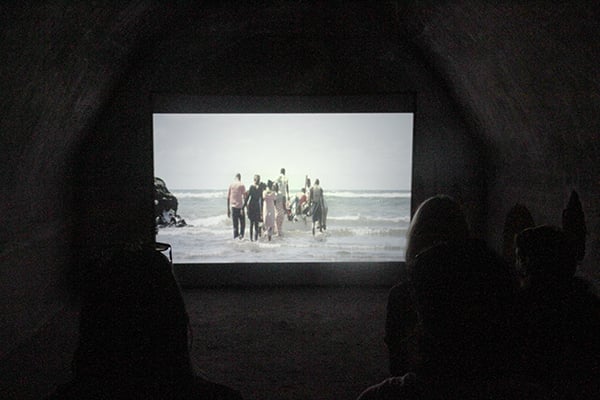Art World
A Diary of the Marrakech Bienniale in 12 Stunning Pictures
The exhibition asks how we surpass the cultural orientation towards newness.

The exhibition asks how we surpass the cultural orientation towards newness.

Job Piston

There is no sense of tourism when it comes to the 6th Marrakech Biennale. That’s owing in part to the work of Reem Fadda, associate curator of Middle Eastern art for the Abu Dhabi Project at the Guggenheim. The biennale presents a main exhibition, with the work of roughly 50 artists, many of whom were invited to create site-specific work that reflects on a world in crisis and propose a step forward. Alongside the main show, there was a series of projects staged in various sites in the Moroccan city.
Fadda kicked off the festivities by noting that it was only by virtue of living amongst the people of Marrakech that one could acquire a knowledge of and begin a true dialogue with the culture. On Fadda’s mind while curating the show were the Syrian refugee crisis, racial conflict, and wealth inequality as a symptom of a world in flux. Her position is exemplified by the title of the biennial, NOT NEW NOW, which is an exegesis of sorts for the festival: NOT refers to a critical position that questions power and the distribution of wealth; NEW addresses modernity and post-colonial life in Morocco; and NOW serves as an urgent and immediate call to action.
Here are a few of the highlights from the exhibition:
1. Work by El Anatsui, Radouan Mriziga, and Rachid Koraichi (pictured at top) are installed center stage at the El Badi Palace, a historical ruin from the 16th century.

Image: Courtesy of Job Piston
2. The paintings of Farid Belkahia (1934-2014) are installed in the Bahia Palace as part of an exhibition on a group of pioneering Moroccan abstract expressionists from the 1960s and 70s known as the Casablanca group. The group was influenced not only by their education in the United States and Europe, but also by the diverse visual culture and society of Morocco itself. One of the most striking pieces in the show is a leather stretched painting with Berber script in henna.

Image: Courtesy of Job Piston
3. The La Mamounia is a five-star hotel located in the center of Marrakech and has been host to presentations from members of the curatorial team each day.

Image: Courtesy of Job Piston
4. Eric Van Hove (b.1975, Guelma, Algeria), who lives and works in Marrakech, remade the engine of a caterpillar tractor D9T with a collaborative team of craftsmen from Morocco and Indonesia. The work honors American activist Rachel Corrie who was killed in the Gaza Strip while trying to block a D9T tractor that was going to bull-doze a Palestinian home.

Image: Courtesy of Job Piston
5. One of the most enchanting installations is by the artist Dineo Seshee Bopape (B. 1981, Polokwane, South Africa). The artist, who lives and works in Johannesburg), has created a 3D representation of a South African liberation song entitled Azania, by way of free-standing totems dressed with coat hangers and wooden spoons. Each arrangement includes soil from several embassies across Africa, from Cairo to Madagascar while the walls of the room are decorated with stickers of indigenous South African flowers.

Image: Courtesy of Job Piston
6. Mohamed Melehi (b. 1936, Asilah, Morocco), who lives and works in Marrakech and Tangier, was also a member of the Casablanca group that defined Moroccan Modernism. Also trained as a graphic designer, many of his paintings have waves or flames that have been said to reflect the gesture of arabic writing or the trance-like state of meditation and prayer.

Image: Courtesy of Job Piston
7. Entrance to the Bahia Palace where the main exhibition begins.

Image: Courtesy of Job Piston
8. Time is Measured by Distance by Saba Innab (b. 1980, Kuwait), who lives and works in Amman and Beirut, is an enormous concrete sculpture that takes the shape of the negative space from the Strait of Gibraltar.

Image: Courtesy of Job Piston
9. Jumana Mana (b. 1987, New Jersey), who lives and works in Jerusalem and Berlin, has created a theatrical display of objects that take the renovations of the el Badi Palace as a point of departure with each sculpture taking inspiration for its form from parts of the floor or wall.

Image: Courtesy of Job Piston
10. A metal stadium by Haig Aivazian (b. 1980, Lebanon) is one sculpture amongst a larger installation which includes a ruined column, a bronzed hand, a sink like sculpture made of bronze.

Image: Courtesy of Job Piston
11. Underneath a mosque during prayer, we watched Kwassa Kwassa, an exceptional short film by SUPERFLEX that takes the Greek myth of Europa and Zeus as a provoking departure point on the migrant passengers of the Comoro Islands. Filmed off the south east coast of Africa, the film contemplates boat makers, passage providers and their voyagers’ eerie fate at sea. The Danish collective SUPERFLEX are a group of artists, architects and designers whose work explores a range of topics from socially engaged art and global economic systems to self-organization.

El Fenn Hotel, Marrakech.
Image: Courtesy of Job Piston